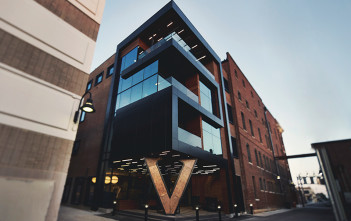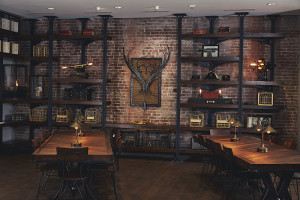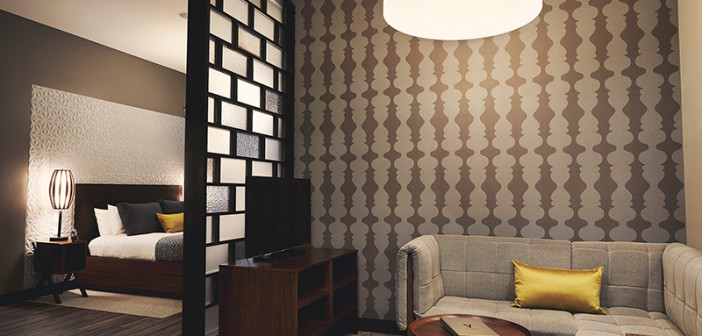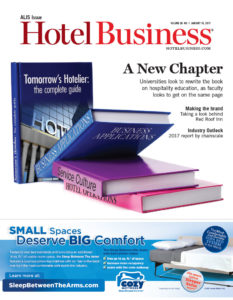Reinvigorating a city’s downtown is a passion for Craig Neddersen, president of IDM Hospitality Management, based in Madison, WI. His team is especially drawn to properties with storied pasts, and through adaptive-reuse, everything old becomes new again.
“Our company was formed by four individuals who had a shared goal to help reinvent downtown city centers and tertiary markets,” said Neddersen. “In 1999, we worked on our first project, but desperately needed a hotel to be a part of the downtown renewal. That’s how it all started, and we’ve done it several times since.”
As a property management firm, IDM’s services run the gamut—economic development to asset management to personalized services—as they work hand-in-hand with clients to achieve their ideal outcome. What’s in the secret sauce? Neddersen revealed it’s twofold: “to know and understand the community, and enable ownership to allow their vision to be realized. It’s also important that their city is represented in the property,” said Neddersen. “We bring the expertise and technical knowledge to create something that meets the metrics and enables the properties to succeed. We also stay and do long-term management.”
As a positive change-agent, IDM’s recipe for success has been proven and acknowledged by industry peers with a recent win: Hotel Vandivort in Springfield, MO, was named Boutique Hotel of the Year by the Boutique & Lifestyle Lodging Association, shortly after the adaptive-reuse hotel marked its one-year anniversary. IDM served as a constant partner and resource to the hotel’s owners (the McQuearys) during all phases of the adaptive-reuse project.
“The vision the McQuearys have is so clear, so we were their assistants all the way through and it’s their vision you see in the end result,” said Neddersen.
 Built in 1906, the four-story Vandivort building has served different purposes, ranging from a Masonic Temple for more than 75 years to subdivided office space. Today, there are no secret handshakes or symbolic rituals taking place, but if you look closely, there are subtle Masonic influences in the hotel’s design. A family-owned hotel, John, Karen and Billy McQueary sought to revitalize a well-known building to provide an entertainment hub that was greatly needed in its thriving downtown for out-of-towners and locals alike, while paying homage to its history and local significance through architectural and design features.
Built in 1906, the four-story Vandivort building has served different purposes, ranging from a Masonic Temple for more than 75 years to subdivided office space. Today, there are no secret handshakes or symbolic rituals taking place, but if you look closely, there are subtle Masonic influences in the hotel’s design. A family-owned hotel, John, Karen and Billy McQueary sought to revitalize a well-known building to provide an entertainment hub that was greatly needed in its thriving downtown for out-of-towners and locals alike, while paying homage to its history and local significance through architectural and design features.
“When we purchased the building, it was almost 110 years old, and there’s a certain kind of mystique to the Masons as well, so that added a fun element. The building is a core piece of identity. We had the concept of the building being a boutique hotel and a cultural economic spark downtown,” said John McQueary. “It was a special fit because of the history. My sister took ballet lessons here when it was an office building and we spent a lot of time here as kids. In terms of how we told the story through the design, we wanted [Masonic] hints without it being a Masonic hotel.”
Karen McQueary led the design process with the intent of restoring the building’s beauty as much as possible by stripping back the clutter and exposing the allure of the raw brick. A 1980s renovation attempt left behind drop ceilings and plenty of drywall to remove. Once the layers were peeled away, a few gems emerged—original iron pillars, crown moldings and intricate detail around the windows. There was also a ballroom on the top floor where the Masons did much of their practice.
To make the hotel’s look current, modern touches were installed in guestrooms such as wet bars, bathrooms with walk-in showers, 55-in. HDTVs, advanced scene lighting controls, in-ceiling speakers, as well as an optional mobile device control of audio, video and lighting. There is also an on-site restaurant, The Order, serving a full breakfast, small plates for lunch and an upscale dinner and drink service.
“It was fairly stripped out when they renovated it. There wasn’t an immense amount of details, but we jumped on every element that was there. We did nods to the history in our design. For our logo, the interior of the V is a plumb bob shape, which is a classic Masonic tool. We tried to key in on details in a subtle way—something they may not notice unless they dig deeper,” said Karen McQueary.
Being a project for the community, it was essential to bring a local aspect to the vintage industrial vibe of the design. The owners engaged local artisans for one-of-a-kind art pieces to be displayed within the hotel for a truly authentic, hyperlocal experience.
“It’s the very best of Springfield. We went to a glass blower around the corner from the hotel and worked with them to create this massive light fixture, which is a focal piece of the restaurant. There are 91 hanging plumb bob fixtures. You might glance at them and see them as glass elements, but we reference a number of different shapes, as well as having it hand blown over a year’s time. That’s about as local as you can get,” said Karen McQueary.
While fairly new to the hospitality industry, the McQuearys are aware of what consumers are searching for in a hotel stay. Additional decor in the form of Masonic artifacts are tied to the locality and help continue the narrative of the design.
 “More and more in this industry, people want that story and emotional connection. People spend time reading and looking at artifacts and enjoy finding that historical connection,” said John McQueary. “We tracked down some of the Masonic initiation coins and I spent time looking for a postcard made of the building. I now have a big stack postmarked in 1919 and information about events that happened in the building. We have them on display in the library, along with a few other items, such as Scottish rites ceremony hats.”
“More and more in this industry, people want that story and emotional connection. People spend time reading and looking at artifacts and enjoy finding that historical connection,” said John McQueary. “We tracked down some of the Masonic initiation coins and I spent time looking for a postcard made of the building. I now have a big stack postmarked in 1919 and information about events that happened in the building. We have them on display in the library, along with a few other items, such as Scottish rites ceremony hats.”
The Vandivort project is all about embracing and connecting to a building’s past, which neatly dovetails with IDM’s ability to preserve the past while putting a new spin on its future.
“The crowning achievement for the McQuearys is that it’s sophisticated in design, but authentically tied to the history. The hotel could be in a premier city, with its finishes and design elements,” said Neddersen. “It’s remarkable how well it has done in the marketplace. Here is this independent hotel right smack downtown. We’re $30-40 dollars ahead of our competitive set and it’s a really viable project. People ask us all the time how our boutique hotels can compete against brands because they have the loyalty programs. There’s transactional and emotional loyalty, and our hotels evoke emotional loyalty.” HB


